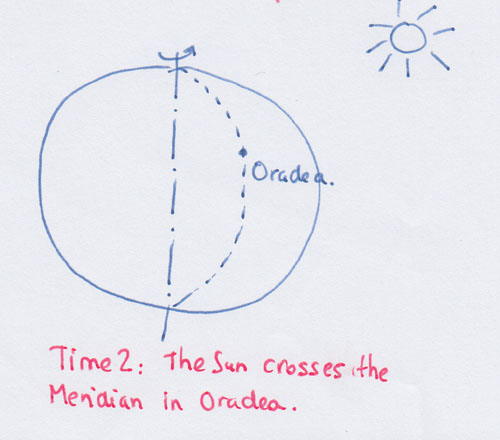Longitude measurement with the galilean satellites
by
Philippe Jeanjacquot
—
last modified
Jul 13, 2012 04:06 PM
Introduction
The longitude was very difficult to measure. It is linked with the rotation of the Earth. To measure the longitude we need to have exactly the same time in different places of the Earth. One of the methods to get the same time everywhere is to look at a celestial stopwatch. Galileo found that it was possible to do with the Jupiter's satellites eclipses as stopwatch. Of course, we can see the eclipse at the same time, everywhere in the world; we just need an eclipse, the night and Jupiter in the sky. After Galileo, Cassini used and improved this method.
Our workshop
With 15 year old students, according to this method, we build a workshop to measure the longitude of Oradea City(Romania) during a European meeting (see the Comenius project: METER).
To find the longitude we have to measure the time T1 when we observe the Jupiter satellite eclipse. We were in Oradea at the beginning of May 2010. We found an eclipse at T1=4h24min the 8 of May (Io began to cross Jupiter). At T1 we start a stopwatch and we stop it at T2 when the Sun crosses the Meridian (South). In Oradea, the 8 of May the Sun crosses the Meridian at 10h29min. It is T2-T1=6h05min after the eclipse. For the longitude calculation we have to know when the Sun crosses the meridian in Greenwich the same day: It is at T3=11h57min. It is T3-T1=7h33min after the eclipse.
Between the T3-T1 and T2-T1 we have a difference of T=1h28min or T=88min. The Earth takes 1436 min to rotate on herself (the angle for a total rotation is 360°). So to get the longitude we have to divide the T time by 1436min and multiply by 360° and we get 22°. In Oradea the longitude is: 21°56’.

 |
 |
 |
In fact, we need to measure with the same stopwatch the time of the eclipse T1 and the time when the Sun crosses the meridian T2 at the place where we want to know the longitude. We need a table with the time of the eclipse T1 in UTC and the time T3 when the sun crosses a meridian where we know the longitude (for example in Greenwich).
About the accuracy
The measurement of the satellite eclipses have to be very accurate. A mistake of 1min mean a longitude error of 0°15’ , according to the Earth perimeter, it gives an error of 28km.
Using Stellarium.
For the simulations of the observations we worked with Stellarium software. With this software we can measure The different times in different locations (Greenwich and Oradea for example)
Links
All the datas are at the IMCCE, Institut de mécanique celeste et de calcul des ephemerides, website: http://www.imcce.fr
The Jupiter's satellites datas are here:
http://www.imcce.fr/langues/en/ephemerides/phenomenes/ephesat/predictions/Jupiter/phenJup.php
The IMCCE provides also an article (in french about the history of this method:
www.imcce.fr/newsletter/docs/episode5-mai10.pdf
Downloads
Document Actions

